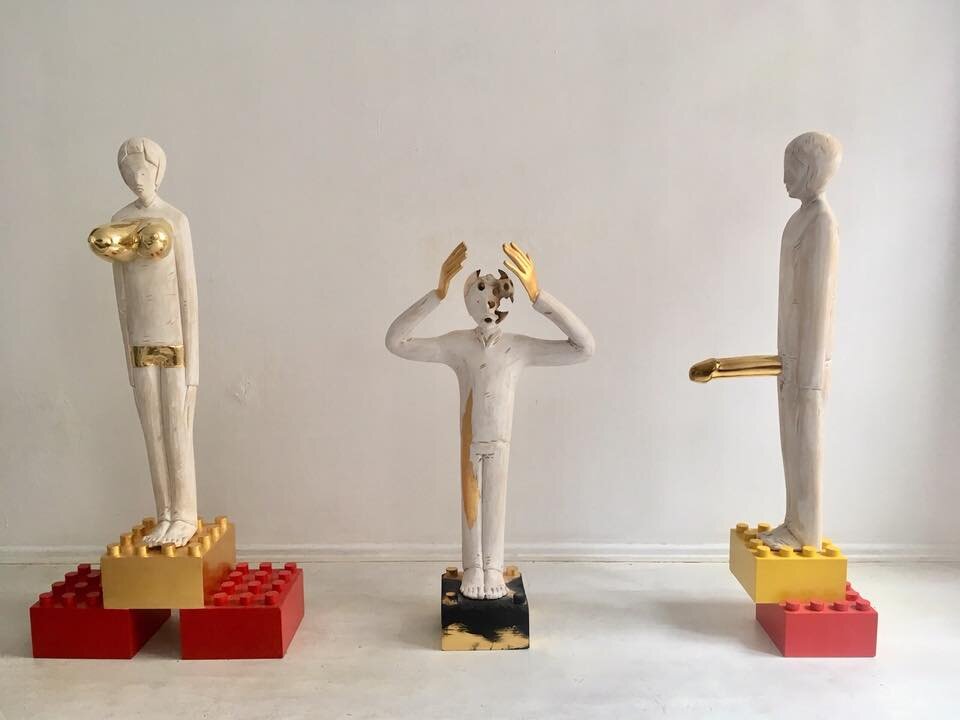The Wry Sculpture of Ivan Lardschneider
As an American living in the northeast megapolis, I see Europe from an art historical perspective, as a horizontal timeline. When I think about the sculpture of Ivan Lardschneider, this trusted reference goes awry. It flips and becomes vertical: down into the earth and up into the air. Twenty miles horizontally might represent a trip to the grocery store, but twenty miles straight up or down? Forget about it.
So, I’m driving my Nissan Versa along the old, horizontal timeline. Let’s say I start in New York City, zip across the ocean, and voila: I’m in Europe and every exit sign is for some period of art. In Northern Italy, I stop my car; it doesn’t drive straight up and down. Believe me, I tried.
Installation view. Image courtesy of the artist.
Welcome to Val Gardena. Woodcarvers have lived and worked in this valley for centuries. Churches throughout the world are populated with altars and statues carved in Val Gardena. Eventually, secular figurines and toys were added to the ecclesiastical repertoire.
This is where Ivan Lardschneider was born in 1976, and here, he continues the tradition of carving in linden wood. That he emerged from this place is enough information. Upon viewing his sculpture, I put the business of tradition, technique and craft away. The convention of lineage and influence only increases the mystery of Lardschneider’s forms. A sensation of hard earthbound artifact and celestial anything-is-possible airiness inform us that we are in the Zeitgeist of hyper-history. Ivan Lardschneider is a contemporary artist, after all: he has exhibited internationally and was featured in the 54th Venice Biennale.
Installation view. Image courtesy of the artist.
Much has been written about his work’s childish playfulness and simplicity. But when we see the “adult pieces” with their golden erogenous zones, gravity yanks us back. What now? Consult Freud? This work requires more than tired twentieth century psychological analysis.
I think of a recurring motif in his carved figures where disproportionally large heads bow down to earth. These figures could easily occur on the plane occupied by Giacometti’s ungainly human forms. Only their vertical lightness keeps them balanced, albeit precariously. The unfussy simplicity of Lardschneider’s carving adds whimsy that lifts them just above an archeological dig. It’s like seeing Otzi on a Ferris wheel.
Installation view. Image courtesy of the artist.
The brightly colored Lego blocks Lardschneider incorporates into his sculptures serve as anchors to the familiar, or as contemporary artifacts: Paleolithic/Etruscan/Lego/et cetera. Oddly, I worry that these Legos might age and, counterintuitively, that the carvings representing human flesh will stay as they are, forever.
Cartoony body parts try to mitigate this gravitas. The huge head, for example, is a laugh riot – for about a second. Just enough time to be interesting in a bait-the-trap kind of way, like Pop Art: get the crowd in for a goof and fifty years later we are left with Last Suppers and electric chairs. This Poppishness wards off Surrealism. There are other sculptors in the region working in that vein, but not Lardschneider.
Confession, mixed media, dimensions variable. Image courtesy of the artist.
Confession is a kneeling figure with gigantic supplicant hands. I smile at my reflection in this hapless being until it takes on the dark comedy of a rubber crutch. The humor’s shelf-life expires; I limp away. Left alone, the carving assumes its little comedy. It’s alive, waiting like a Venus flytrap.
The golden body parts! First, let me say, the gold works. Gold suggests the unimaginably daunting mathematical fate that allows for individual human existence and sentience; an oasis of nature’s reasonable will. Here, we can unfold our chairs and sit a while. Time’s up. Our brief sit-down in utopia is over. Back to our reality of half-fictions, our hyper-historical Zeitgeist.
Installation view. Image courtesy of the artist.
How does an artist express this human condition without being ugly/obvious? A bullseye shot is required, but is rarely delivered. I like to think it is best achieved by not having a target at all – at least not “that” target. Here I think of some Americans: Homer, Hopper, Pollack, and Warhol, whose decoy subjects lure one that’s higher, more resonant. Time and critical literature help to illuminate this second subject. I stop here to ponder a Henry Miller quote: “The worst sin that can be committed against the artist is to take him at his word, to see in his work a fulfillment instead of a horizon.” With this caution, I back off.





